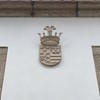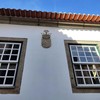Paranhos da Beira
Paranhos da Beira is a Portuguese parish in the municipality of Seia , with an area of 21.01 km² and 1265 inhabitants ( 2021 census ). Its population density is 60.2 inhabitants/km².
Its headquarters, the village of Paranhos, was elevated to the category of village in 1989 , changing its name from Paranhos to Paranhos da Beira.
The parish of Paranhos comprises the villages of Carvalhal da Louça , Vale da Igreja and Chaveiral . They all have chapels where religious festivals are held annually.
History
Its origin dates back to prehistoric times, as evidenced by the dolmen of Carvalhal da Louça , which has since been classified as a Monument of National Interest . It is 2.80 m in diameter and 2 m high, in the shape of a pyramid trunk with a decagonal base, consisting of nine almost trapezoidal pillars, inclined towards the center, with the exception of the master key in a vertical position, the adjacent pillars forming a kind of wedges; east-facing entrance; the stalwarts present their entire height with the exception of one stalwart to the south. At about half its original height; the lid is carved with a Greek cross and a lanceolate cross. Corridor: the pillars are fragmented and semi-fragmented.
Associativities
It is also important to mention the communities in this village, such as the Sports Association of Paranhos da Beira, the Cultural and Recreational Association of Paranhos da Beira or the Rancho Folclórica de Paranhos da Beira.
Pottery in Paranhos da Beira and Carvalhal da Louça
Paranhos da Beira and Carvalhal da Louça have an ancestral tradition in the art of artisanal clay pottery, dedicated to the production of utensils for domestic use, such as crockery for preserving food, and for agricultural tasks ("field activities") .
It is currently possible to visit, in the old building of the Primary School, a Museum Centre created by the Rancho Folclórica de Paranhos da Beira dedicated to this work.
Portugal
Portugal, officially the Portuguese Republic, is a country located on the Iberian Peninsula, in southwestern Europe, and whose territory also includes the Atlantic archipelagos of the Azores and Madeira. It features the westernmost point in continental Europe, and its Iberian portion is bordered to the west and south by the Atlantic Ocean and to the north and east by Spain, the sole country to have a land border with Portugal. Its two archipelagos form two autonomous regions with their own regional governments. Lisbon is the capital and largest city by population.
One of the oldest countries in Europe, its territory has been continuously settled, invaded and fought over since prehistoric times. The territory was first inhabited by pre-Roman and Celtic peoples (at the time of the first large-scale Roman invasions in Western Iberia, they preponderantly were the Lusitanians, the Gallaecians, the Celtici and, to some extent, the Conii). These peoples had commercial and some cultural contact with Phoenicians, ancient Greeks and Carthaginians. It was later ruled by the Romans, followed by the invasions of Germanic peoples (most prominently, the Suebi and the Visigoths) together with the Alans, and later the Moors, who were eventually expelled during the Reconquista. Founded first as a county within the Kingdom of León in 868, the country officially gained its independence as the Kingdom of Portugal with the Treaty of Zamora in 1143.
In the 15th and 16th centuries, Portugal established one of the longest-lived maritime and commercial empires, becoming one of the main economic and political powers of the time. At the end of the 16th century, however, Portugal suffered a war for the crown succession which led to the incorporation of the country into the Spanish monarchy during the Iberian Union.
By the early 19th century, the accumulative crisis, events such as the 1755 Lisbon earthquake, the country's occupation during the Napoleonic Wars, and the resulting independence of Brazil in 1822 led to a marked decay of Portugal's prior opulence. This was followed by the civil war between liberal constitutionalists and conservative absolutists over royal succession, which lasted from 1828 to 1834. The 1910 revolution deposed Portugal's centuries-old monarchy, and established the democratic but unstable Portuguese First Republic, later being superseded by the Estado Novo (New State) authoritarian regime. Democracy was restored after the Carnation Revolution (1974), ending the Portuguese Colonial War and eventually losing its remaining colonial possessions.
Portugal has left a profound cultural, architectural and linguistic influence across the globe, with a legacy of around 250 million Portuguese speakers around the world. It is a developed country with an advanced economy which holds the 14th largest gold reserve at its national central bank representing the highest percentage share held in gold of total foreign reserves by any nation, the 8th largest proven reserves of lithium, with the weight of exports representing 49% of its GDP in 2022. A member of the United Nations, the European Union, the Schengen Area and the Council of Europe (CoE), Portugal was also one of the founding members of NATO, the eurozone, the OECD, and the Community of Portuguese Language Countries. By 2021, Portugal had the 4th lowest GDP per capita (PPP) of the eurozone.

































































































































